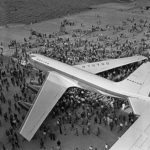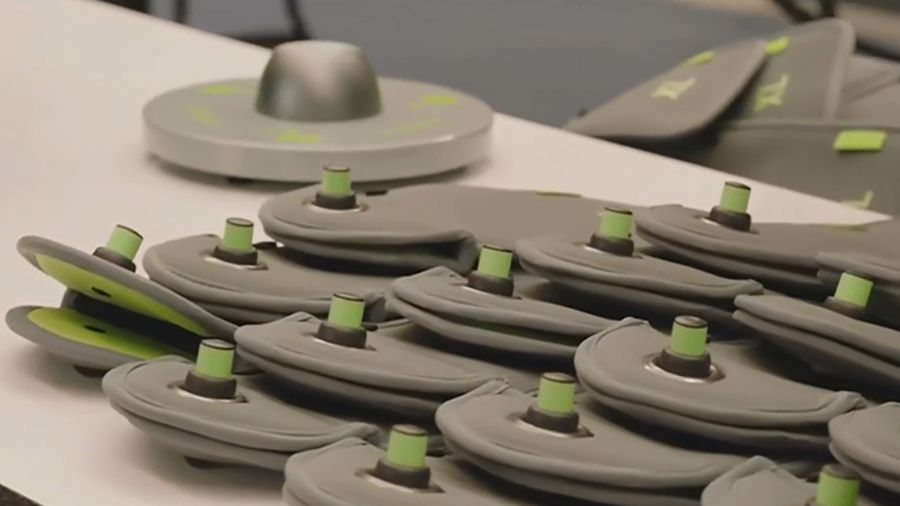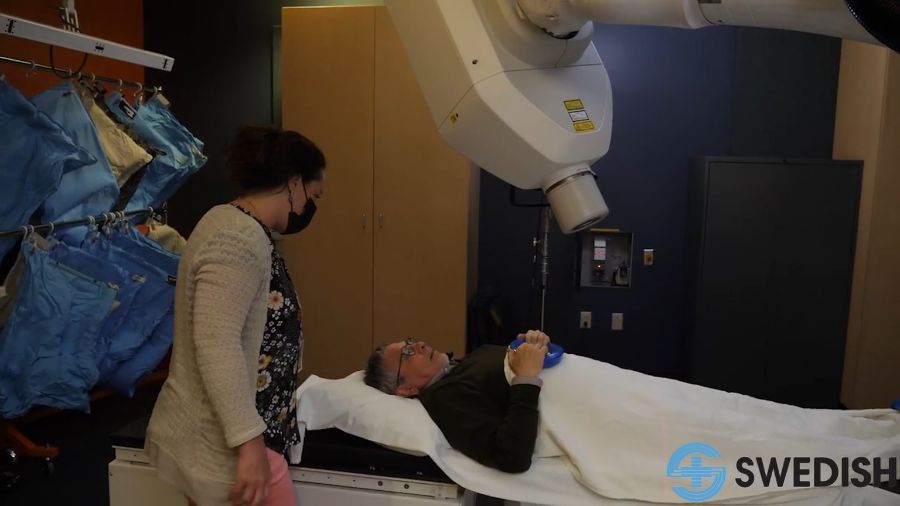The game-changing Boeing 707 jet debuted 70 years ago
May 15, 2024, 8:20 AM | Updated: 8:41 am
News broke on Tuesday, May 14, 2024 that, according to the Associated Press, “Boeing has violated a settlement that allowed the company to avoid criminal prosecution after two deadly crashes involving its 737 Max aircraft more than five years ago, the Justice Department told a federal judge.”
Tuesday was also the 70th anniversary of the rollout of the company’s “Dash 80” prototype on May 14, 1954 — which soon elevated Boeing to the top of the aviation/aerospace world. KIRO Newsradio’s resident historian Feliks Banel prepared this story for the 65th anniversary of the rollout back in 2019.
Originally published May 15, 2019
As Boeing works to fix the grounded 737 MAX after two deadly crashes, the jet manufacturer quietly marked an important milestone of its role as a manufacturer of both civilian and military aircraft.
It was 65 years ago this week when the company staged the rollout of its original game-changing jetliner, and cemented its decades-long role as the dominant economic and even cultural force in Seattle and the Pacific Northwest.
On Friday, May 14, 1954, just after 4 p.m., the “Model 707” prototype – also known as the “Dash 80” – debuted at the Boeing factory in Renton on the shores of Lake Washington. The 707’s design, with swept-wings and four pod-mounted jet engines, was revolutionary.
More on Boeing: Justice Department claims Boeing violated deal that avoided prosecution after crashes
Author and former New York Times journalist Sam Howe Verhovek wrote a book a decade ago about the development and ultimate success of the Boeing 707 called “Jet Age.”
“The significance of the Dash 80 was Boeing leaped into the future and really ahead of either of the other big airplane manufacturers, Douglas or Lockheed,” Verhovek said. “Boeing decided to bet the company on building a jet airliner before anybody else did.”
The Boeing 707
The cool thing about the “Model 707” was that it was a prototype aimed to serve two very different markets.
One was as a civilian jetliner for sale to airlines, which was revolutionary in those years of trains and prop planes, and which made the $15 million dollars (or about $143 million in 2019) that Boeing invested in its development a risky bet. The other market was for military use, as an airborne refueling tanker to gas up those jet-powered, high-flying Boeing B-52 bombers that had been flying since 1952. This potential market made the Boeing 707 bet seem not so crazy after all.
Boeing CEO William M. “Bill” Allen spoke at the rollout in Renton. He pointed out how exactly 10 years to the day earlier, the 5000th iconic B-17 bomber had rolled off a wartime Boeing assembly line. Allen also explained the potential benefits of the company’s dual-market thinking in those early years of the Cold War and the dawn of the Jet Age.
“If we are right in our analysis, this airplane will mean much to us as employees of Boeing,” Allen said. “It will also give our Pacific Northwest community the prestige of leadership in a new field and the potential of new business. Most significantly, it can add to the security of our nation and the ties of communication, which are a part of its growth.”
Incredibly enough, it seems that Boeing was simultaneously building a flying sword and a flying plowshare.
The rollout in Renton
The rollout was a pretty brief event. Organizers timed it for 4 p.m. on a Friday, so the day shift and the swing shift workers could all be there. The Renton High School marching band performed, and an estimated 8,000 people were watching and listening.
Those 8,000 people witnessed the most poignant moment in the program, when William Allen described the vision and courage necessary to start an airplane company in the dark aviation ages of 1916. Then, Allen introduced the man responsible for it all: the company’s aging founder.
“Thirty-eight years ago, Mr. W.E. Boeing had that vision and that courage, and from it has grown the Boeing Airplane Company of today,” Allen said. “It is with the greatest pleasure that I present to you the founder of our company, W.E. Boeing.”
Applause erupted for Bill Boeing, and then quickly subsided. Boeing acknowledged the introduction, but he never spoke at the 707 rollout.
He’d left the company in the 1930s in bitterness, some claimed, after the government broke up Boeing into separate and independent airplane manufacturing, engine building and airline companies. He was also ailing; he’d eventually pass away a little more than two years later, just shy of his 75th birthday.
More from Feliks Banel: Visiting Captain Vancouver’s grave in a tiny village near London
But Boeing’s wife Bertha was also there in Renton 65 years ago, and just as she’d done for one of the company’s first planes back in the 1920s, she did the honors for the Model 707 with a bottle of champagne.
“Mrs. Boeing,” William Allen asked her, “will you please christen the airplane?”
“Today, I’m really christening twins,” Bertha Boeing said. “This airplane has several possible uses, whether that use be military for our security or commercial for our welfare, I know that you will all join me in wishing her a glorious future.”
And then, just before the microphone picked up the unmistakable sound of a bottle of bubbly breaking on a Boeing 707, Bertha intoned, “I christen thee the Airplane of Tomorrow, the Boeing Jet Stratotanker, Stratoliner.”
With that, the new jet was towed from inside a hangar and out onto the tarmac not far from the waters of Lake Washington.
The Model 707 prototype was supposed to fly for the first time later that month, but the left landing gear collapsed during a taxiing test at Renton on May 21, and the maiden flight was delayed until July 15, 1954. That flight and dozens more that followed were, fortunately, more successful than the taxiing test. Famed test pilot Tex Johnston’s famous barrel roll of the plane came a year later during Seafair festivities of 1955.
The jet age
The aircraft program went on to great success for Boeing in the late 1960s, both as the 707 civilian jetliner and military KC-135 tanker. And, it could be argued, all jetliners today still look like, and actually essentially are, variations on the now more than 65-year old Boeing 707.
Boeing launched several successful jetliners in the 1960s, including the 727, 737, and 747; as well as stumbled with the cancellation by the federal government of the program to develop a “Supersonic Transport” or SST. When the Apollo astronauts covered serious miles on the surface of the moon, they did it in Boeing-built lunar rovers.
In 2001, after absorbing former chief competitor McDonnell Douglas, Boeing moved its headquarters to Chicago. Then, nearly a decade later and after long delays, the 787 Dreamliner debuted, and Boeing opened a second production line for that model – its first ever outside of Washington for jetliners – in South Carolina. Boeing is also poised to be a big part of NASA’s next phase of space exploration.
Sam Howe Verhovek said that these are very different times than 65 years ago.
“(Boeing CEO) Bill Allen was fully committed to the Northwest and … Boeing certainly thought of itself as a Seattle- and Northwest-based company in the 1950s,” Verhovek said. “In today’s world, I think corporate loyalties to place tend to be more fickle.”
And what do changes for Boeing – and those fickle corporate loyalties – mean for Seattle and the Northwest?
“I’ve thought a lot about this question,” Verhovek said. “And I don’t want to paint the 1950s Boeing in an overly rosy way, because there certainly were labor disputes and threatened strikes from time to time. But, basically, when you look at that era, there was such a feeling of pride in what people were doing, and everybody was really focused on turning out this great airplane and were very proud of it.”
More from Feliks Banel: Grassroots preservation campaign saves Parkland School
And how has Seattle and the people who work for Boeing weathered the tough times?
“It’s been hard for Seattle as the home of this great company, it’s been hard to see the company get divided in this way,” Verhovek said. “They still turn out great airplanes and I think that this problem with the 737 MAX will be overcome, will be fixed, but nothing that anybody does is going to bring back the 500 or so people that died in these crashes.”
Until that problem is overcome, 737 MAX jets are still being assembled at the Boeing plant in Renton. And many of those idled planes are now parked on what this one-time “hometown” company – and the Northwest economy it helped build along with all those jets – might still be able to think of as hallowed ground.
It’s the same spot where Bill Boeing and 8,000 Boeing workers watched Bertha Boeing christen the Model 707 exactly 65 years ago.
You can hear Feliks every Wednesday and Friday morning on Seattle’s Morning News with Dave Ross and Colleen O’Brien, read more from him, follow him on X here and subscribe to The Resident Historian Podcast here. If you have a story idea or a question about Northwest history, please email Feliks here.




















